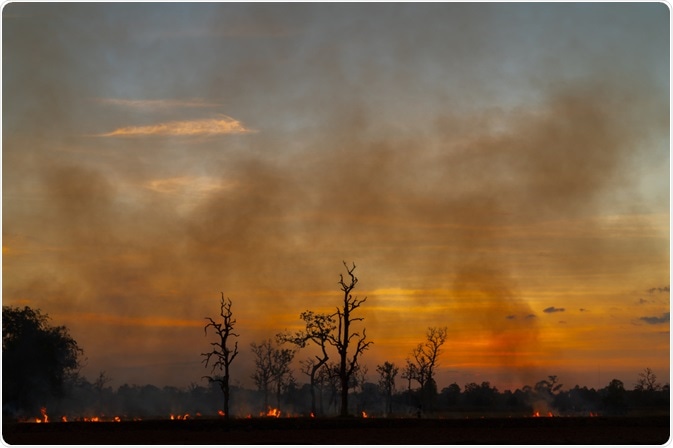Climate change is considered to be one of the most significant current threats to human health. The overall impact of climate change on human health is overwhelmingly negative and it has been shown to affect multiple factors that contribute to health.
Without significant progress to tackle climate change, human physical and mental health will continue to be detrimentally impacted and unnecessary deaths will increase.
 Image Credit: Khongtham/Shutterstock.com
Image Credit: Khongtham/Shutterstock.com
Climate change
Over the last 130 years, the temperature of planet Earth has risen by 0.85oC. Each passing decade over the last thirty years has been successively warmer than any previous decade.
Looking at a graph of temperatures plotted over the last 800,000 years, a pattern of atmospheric carbon dioxide gradually rising and falling can be seen until 1950 when levels exponentially increased to reach current unprecedented levels that show no signs of decreasing. Scientists believe that there is a greater than 95% probability that this trend is due to human activity and that the situation will worsen if significant action is not taken.
Climate change is having a detrimental impact on the environment and the animals and humans who inhabit it. Recent research has highlighted the negative impact climate change has on the social and environmental factors that determine human health, such as clean air, extreme weather events, food resource, safe drinking water, and secure shelter.
Here, we discuss the various ways in which climate change is impacting human health.
Vectorborne and zoonotic diseases
Vectorborne and zoonotic diseases (VBZD) are transmitted via animal hosts or vectors. Vectorborne diseases (e.g. malaria) are carried by an organism and transmitted to a human host, often via a bite. Zoonoses (e.g. the viruses causing Avian Flu and COVID-19) are transmitted to humans, often via direct contact with infected animals or through vectors that transport zoonotic pathogens from animals to humans.
Climate Change and COVID-19
Many VBZD are more prevalent in warmer climates and for this reason, were originally confined to warmer regions of the world. Now, the locations in which VBZD can proliferate are expanding due to the increased global temperatures caused by climate change. In particular, climate change is being held responsible for advancing VBZD such as dengue and malaria.
Furthermore, climate change and its resultant extreme weather and temperature fluctuations are disrupting animal habitats. As a result, animals such as bats are visiting unusual places, coming into contact with humans and other species in situations where they would not normally meet. This is increasing the chance of spillover events, where zoonotic diseases jump between species. The wildlife trade is another exacerbator of this phenomenon.
In the past 20 years, there have been three outbreaks of zoonotic coronavirus, the most recent being the COVID-19 pandemic which brought the entire world to a stop. If climate change continues on its current trajectory, many researchers have gathered evidence that these pandemics will become more commonplace.
Food and waterborne diseases
Climate change has an influence on the environmental drivers of food- and waterborne diseases. Research has demonstrated that temperature regulates the replication cycles of the pathogens that underpin the most common food and waterborne diseases.
Elevated ambient temperatures that are the results of climate change are, therefore, increasing the prevalence of such diseases. In particular, evidence shows that bad water, sanitation and hygiene resulting from climate change are increasing food and waterborne diseases.
Additionally, extreme weather events such as floods are further exacerbating the problem by increasing the spread of these infectious diseases through water systems.
Air pollution
Recent research has found that the increasing temperatures due to climate changes are shifting climatic conditions and reducing air quality by increasing ground-level ozone and particulate matter air pollution.
Numerous studies have related ground-level ozone with multiple severe and life-threatening health problems such as asthmas and lung disease. Exposure to low-quality air is also related to increases in emergency room admissions and premature deaths.
Mental health and stress
A growing body of research is revealing the links between climate change and mental health. The relationship is complex and involves multiple direct and indirect consequences of climate change.
Primarily, climate change has been shown to decrease air quality, which has been shown to worsen many health conditions including mental health disorders. There has been considerable research linking exposure to contaminated air with dementia.
Additionally, climate change is indirectly increasing mental health problems such as anxiety, depression and post-traumatic stress disorder due to the significant amount of stress and distress caused by experiencing extreme weather events such as floods, heatwaves, and droughts. There is also a plethora of evidence showing that environmental stresses such as natural disasters can have dramatic impacts on maternal and child health.
As climate change increases the prevalence of these events, it also increases the risk of mental health issues.
Food security
Increasing temperatures, changing rainfall and more prevalent extreme weather events are related to decreasing crop yields of many food staples. Climate change-induced increasing weed and pest populations also contribute to this and will result in an increased use of herbicides and pesticides, affecting the health of those exposed to them.
The decrease in crop yields has led to both rising food prices and reduced wages of the most vulnerable populations in the world’s poorest regions. Climate change is also projected to affect atmospheric and soil conditions, reducing the nutritional value of some foods. Meanwhile, livestock and fish populations are also suffering and projected to decline.
Experts predict that malnutrition and undernutrition, which currently accounts for over 3 million deaths annually, will increase if nothing is done to tackle climate change. As food prices increase, some people will have little access to food, leading to increased levels of starvation, and others may turn to cheaper, less nutritional but calorific foodstuffs, leading to malnutrition and obesity levels increasing.
Extreme temperatures
Data shows that from 1880 to 2005 extreme high-temperature events (e.g. heatwaves) doubled in their average length. Additionally, the frequency of hot days during the same timeframe tripled.
Studies have shown that extreme heat has a negative impact on physical and mental health and increases the risk of disease and death. Importantly, extreme heat poses a particular risk to those taking psychoactive medication as it can reduce the body’s ability to regulate temperature and lead to hyperthermia.
Allergens
The proteins of pollen and fungal spores that underpin common allergies are impacted by climate change. In addition, factors that impact the release and availability of such spores in the air are also influenced by climate change.
In short, evidence has shown that climate change and shifts in precipitation patterns, air temperatures and CO2 levels may alter the pollen seasons of spore-producing plants as well as alter the duration and intensity of these seasons, thus impacting allergic disorders including asthma, rhinitis, and conjunctivitis.
Increased rainfall and temperatures can also lead to indoor air quality issues, for example increasing mold growth, affecting those with respiratory conditions.
 Image Credit: frank60/Shutterstock.com
Image Credit: frank60/Shutterstock.com
Wildfires
Wildfires have become 30% more likely and their average duration has lengthened as a result of climate change. Data has shown that the greenhouse gases produced by wildfires account for around 5-8% of the 3.3 million premature deaths that occur annually due to poor air quality.
Conclusion
If the climate continues to change on its current trajectory, the health of the entire population will continue to be affected through ways such as those listed in this article, impacting the most vulnerable populations first. This article is not exhaustive – there are numerous direct and indirect impacts of climate change on human health, some of which have already begun and some which are yet to come.
Climate change is a universal health problem, causing a multitude of health issues that could be largely prevented in many cases if sufficient action were taken. Without this action, the issues will only get worse.
References
- Archer, C., Brodie, J. and Rauscher, S., 2019. Global Warming Will Aggravate Ozone Pollution in the U.S. Mid-Atlantic. Journal of Applied Meteorology and Climatology, 58(6), pp.1267-1278. https://journals.ametsoc.org/view/journals/apme/58/6/jamc-d-18-0263.1.xml
- Caminade, C., McIntyre, K. and Jones, A., 2018. Impact of recent and future climate change on vector-borne diseases. Annals of the New York Academy of Sciences, 1436(1), pp.157-173. https://www.ncbi.nlm.nih.gov/pmc/articles/PMC6378404/
- Cianconi, P., Betrò, S. and Janiri, L., 2020. The Impact of Climate Change on Mental Health: A Systematic Descriptive Review. Frontiers in Psychiatry, 11. https://www.frontiersin.org/articles/10.3389/fpsyt.2020.00074/full
- Climate Change: How Do We Know? Nasa. Available at: https://climate.nasa.gov/evidence/
- Climate change and health. World Health Organization. https://www.who.int/news-room/fact-sheets/detail/climate-change-and-health
- Climate Effects on Health. Centers for Disease Control and Prevention. Available at: https://www.cdc.gov/climateandhealth/effects/default.htm
- Semenza, J., Herbst, S., Rechenburg, A., Suk, J., Höser, C., Schreiber, C. and Kistemann, T., 2012. Climate Change Impact Assessment of Food- and Waterborne Diseases. Critical Reviews in Environmental Science and Technology, 42(8), pp.857-890. https://www.ncbi.nlm.nih.gov/pmc/articles/PMC3996521/
Further Reading
- All Climate Change Content
Last Updated: Apr 5, 2021

Written by
Sarah Moore
After studying Psychology and then Neuroscience, Sarah quickly found her enjoyment for researching and writing research papers; turning to a passion to connect ideas with people through writing.
Source: Read Full Article
